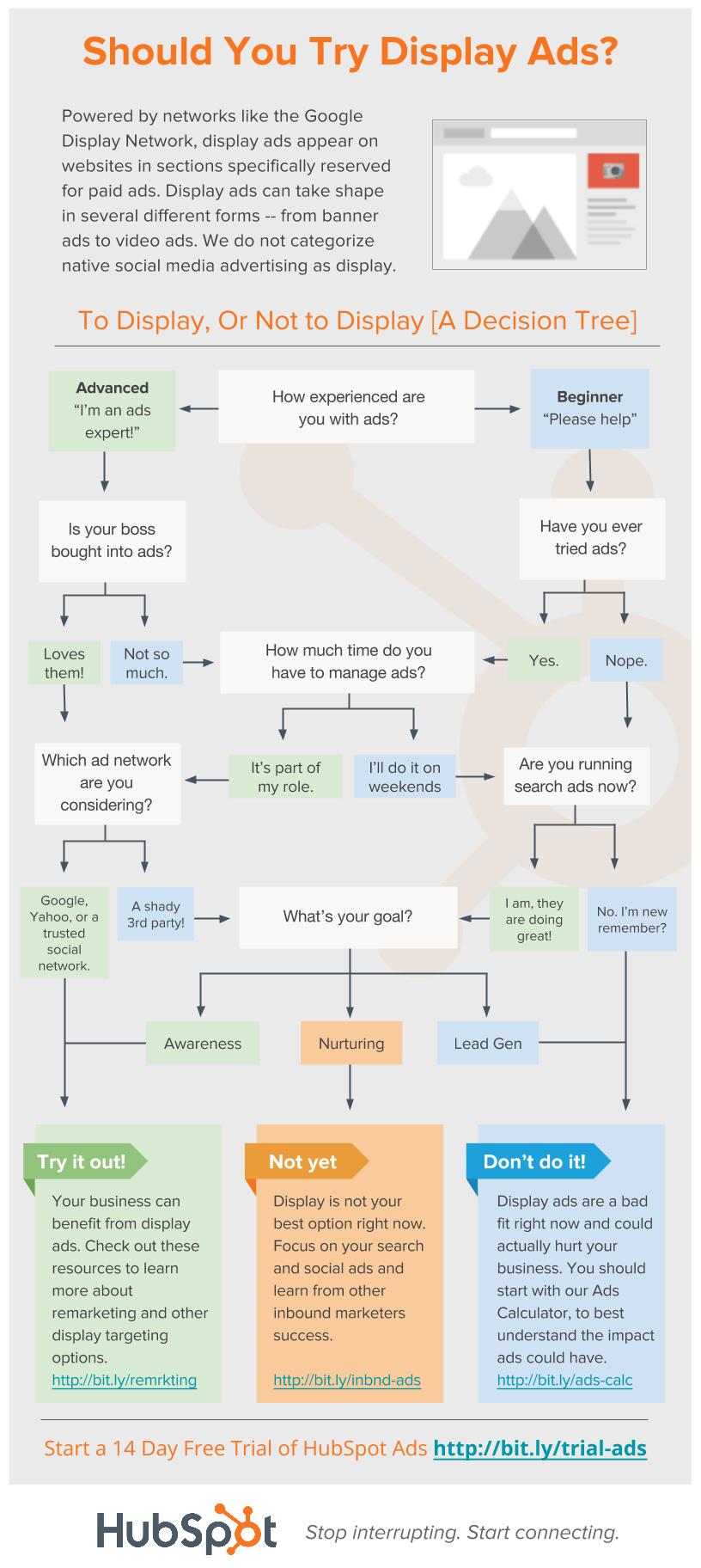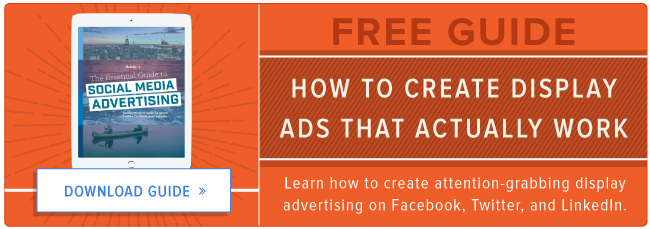
There are a lot of reasons to avoid display ads. In recent years search, social, and video ads have cruised past display as the go-to ad format for digital marketers looking to give their campaigns a boost -- and for good reason. There’s not much to love when you look at display ad performance in aggregate. People don’t generally click on them or trust them, and many are actively blocking them.
However, good marketers know better than to trust data in the aggregate. There's evidence that display is undergoing a bit of a renaissance. Display networks have been infusing data and machine learning into display to create more effective targeting such as Google's Dynamic Remarketing, and smarter automated bidding strategies. These changes are making it possible for some marketers to effectively use display campaigns to build awareness and drive leads.
So should you use display ads? The short answer is probably not, but the flowchart below is a quick way to find out for sure.

Share This Image On Your Site
<p><strong>Please include attribution to www.hubspot.com with this graphic.</strong><br /><br /><a href='http://blog.hubspot.com/marketing/to-display-or-not-to-display'><img src='http://cdn2.hubspot.net/hub/53/hubfs/Should_you_be_using_Display_Ads-_Decision_Tree_4.jpg?t=1466796215403&width=690&height=1543' alt='The HubSpot Guide to Display' width='540px' border='0' /></a></p>Now that you have a foundation to decide whether or not you should use display ads, let's break down the questions marketers should ask themselves before diving in.
7 Questions to Ask Before Launching Display Ads
1) Have you used ads before?
If you are new to ads, don't start with display -- even though they're generally the type of ad that most readily comes to mind. Banner ads were one of the very first ways the internet monetized traffic, but there are now many, many more ad options. While display ads are evolving into a more effective awareness and acquisition tool, I wouldn’t recommend any first-time online advertiser start with them considering they're often more complicated to set up and measure than other ad types.
2) Do you have time to educate yourself on display targeting?
If you are short on time, avoid display. While it's easy to launch a shoddy display campaign in a pinch, if you want your ad to be maximally effective, you need to take the time to understand all the different alternatives display offers -- which include a myriad targeting and creative options. If you’re pressed for time, try-self service social ads like Sponsored Updates or Facebook Lead ads instead.
3) Is your company bought into ads?
If your boss doesn’t like ads, she’ll hate display. Make sure management is bought into the idea of using ads as a way to grow business in the first place before exploring display ads. Display ads can drive relevant traffic to your site, but more often than not, they represent one touchpoint in a long customer journey. Unless you’ve got a sophisticated attribution model built out, it will be hard to calculate accurate ROI from display ad spend. If you need to demonstrate immediate value to your boss, start with a bottom-of-the-funnel ad campaign, which will more directly drive leads.
4) What display network are you considering?
Do you plan to use a third-party ad network that hasn’t established itself yet? Proceed with caution. Some of these companies promise lots of impressions, but bear in mind that impressions don’t grow your business. To move the needle, you need qualified leads, and those only come from a relevant audience. To ensure your ads drive relevant traffic, go with proven partners with great ad technology, such as Google, Yahoo, Facebook, or LinkedIn.
5) Are you in ecommerce or have a long sales cycle?
Display ad technology is more valuable for some industries than others, most notably ecommerce and B2B companies with long, complicated sales cycles. Here's why:
- Ecommerce: Remarketing is a type of display targeting that advertises a specific product or message to a user who has already expressed interest in that product. If you’ve ever put a pair of sneakers in an online shopping cart but ultimately didn’t buy, you may have seen ads like these. Display ads that use remarketing targeting give ecommerce marketers a second chance with a customer they know is interested, and have a much higher CTR than display ads that use more generic targeting. Get an in-depth introduction to remarketing here.
- B2B companies with long sales cycles: With more product information online than ever before, your prospects are doing copious amounts of research before they ever talk to your sales team. Use display and social ads to target prospects who you think are in the market to buy your product. Although it can be hard to measure the impact of these ads, they will ensure your company stays top of mind throughout the buyer’s journey.
6) What’s your goal?
Display ads may or may not be the right choice for your campaign depending on your goal. Are you aiming for awareness, nurturing, or lead generation?
- Awareness: Display ads can be a wonderful way to grow awareness and create demand for your product. While it's always a best practice to get as specific as possible with targeting, display can provide massive reach. Consumer brands or companies that want to drum up awareness fast can benefit from display ads.
- Nurturing: As long as you are using smart targeting, display can also help nurture leads and prospects down your funnel. Use strategic targeting like retargeting, similar audiences, custom audiences, or topic targeting if nurturing is your goal, and make sure your display ads support a larger marketing campaign.
- Lead generation: Generally, display is a bad way to capture leads or drive a specific action from a customer, like filling out a form. If lead generation is your goal, target only the most relevant audience, and use CPC bidding instead of CPM.
7) Are you running Google search campaigns?
If you’re already running Google search campaigns, bottom-of-the-funnel display ads can be a good complement. First, ensure you feel comfortable with the performance and profitability of your existing search campaigns, and then add bottom of the funnel display solutions like Remarketing Lists for Search Ads.
Display ads aren’t right for every B2B advertiser, but they can add significant value in the right situations. Still not sure if display ads are a smart idea for your business? A test never hurts.
Marketing tactics create different results for different companies, so just because something does (or doesn't) work for one organization doesn't mean it will (or won't) for you. When it comes to ads, always trust your own data.
from HubSpot Marketing Blog http://blog.hubspot.com/marketing/display-ads-flowchart
Via http://blog.hubspot.com/marketing/display-ads-flowchart

No comments:
Post a Comment